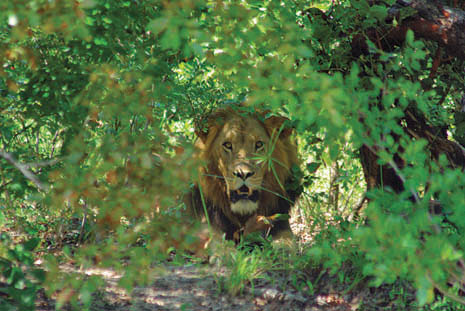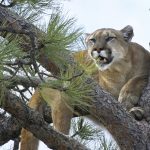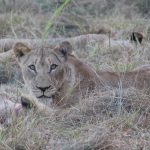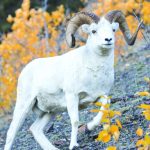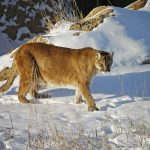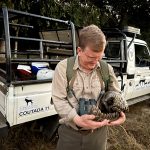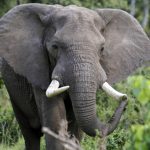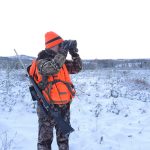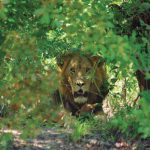How the study of these big African cats helps ensure their future.
No matter how often you’ve heard it, a lion’s growl is still enough to send chills down your spine. Standing atop the utility box in the bed of my Land Cruiser in the sweltering heat of a Zambian October, the sound permeated the air with the overpowering menace of a fast-approaching locomotive. Despite having spent years around lions in the wild, I was foolishly engrossed with another task at hand. At the instant that my preoccupied brain finally registered the danger, the lioness charged. Exploding from the nearby bushes in a tawny blur of coughs and snarls, she rocketed to within a few feet of the Cruiser before stopping abruptly, fixing me with a baleful stare, and vanishing back into the shrubby cover.
I was lucky that day; I was also just plain stupid. Getting distracted when you’re in the bush is risky, and in the close company of large carnivores it can easily become the last mistake you ever make. Statistics tell us that most charges are bluffs, but the jelly-like quality of my knees spoke to the small percentage that culminates in full-blown attacks. Hastily, I crawled down off the toolbox into the relative safety of the cab, the metallic tang of adrenaline sharp on my tongue.
Unknown to me at the time was the fact that this big lioness had small cubs hidden nearby. To add to her annoyance, I had just smacked her in the backside with a biopsy dart to collect DNA as part of my research project on African lions in Zambia. This minimally invasive technique involves no drugs or handling of the animal. Like most of the lions that I had darted, this one had taken being unceremoniously jabbed by the little projectile in relatively good humor. However, the dart containing the sample had bounced underneath the scattering of nearby bushes and disappeared, and my lingering search for it had exhausted her maternal tolerance.
A second lioness watched intently from the other end of the thicket, ready to lend support if necessary. This younger female had somehow lost all but a small stump of her tail. The truncated appendage rendered her oddly terrier-like as she walked away with a last disapproving stare over her shoulder at me, now seated sheepishly behind the steering wheel. Fortunately the charge was only a warning, but the point was well taken: I had crossed the line between mere annoyance and threat, and they would not have to tell me again.
The lionesses had come at a run in response to a recording of a bawling buffalo calf. It didn’t help their mood that they felt cheated out of an easy breakfast. Playing sounds of prey in distress is a popular method for surveying African carnivores, and in addition to lions, spotted hyenas, wild dogs, leopards, and even cheetahs sometimes respond to my calls. I often feel a little guilty when a predator appears on the run, sometimes licking its lips in anticipation, to find nothing more edible than a pickup truck and loudspeaker. But the inherent difficulties of working in largely roadless, thickly vegetated habitats necessitates pulling out all the stops.
Zambia is a premier destination for sport hunting of lions, yet until recently, little was known about the country’s lion populations. Most studies focus on lions that live in open plains or scattered woodlands, often in national parks or private reserves. Much less is known about lion populations that inhabit thickly forested and brushy habitats, or lions that reside in hunting areas. It was for that reason that, in 2003, I first came to Zambia to learn more about the country’s lions in the places where it is hardest to find them. Playback recordings and biopsy sampling are two methods I am utilizing to study lions that spend most of their lives in heavy cover.
Compounding the challenge is the fact that the majority of my work is conducted in hunting blocks called Game Management Areas (GMAs), rather than in the more controlled environments of parks or reserves. The anti-poaching efforts of the hunters and safari operators in these areas result in an abundance of game, but some naturally shy species such as lions can be more reclusive because they are not exposed to the high volume of daily tourist traffic compared to lions that reside within national parks, and because older males are targeted as trophies. Although working under these conditions is far more difficult, that is a big part of what makes this study particularly valuable and exciting.
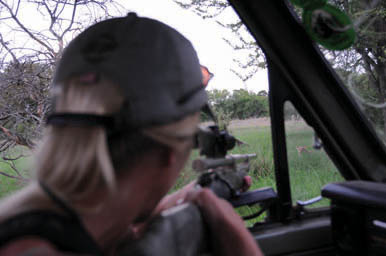
The Zambia Lion Project’s research focuses on promoting sustainable sport hunting of wild lions as a conservation tool. In Kenya, where trophy hunting no longer occurs, lions quickly lost their value outside of the national parks. In contrast, rural communities in Zambia that are involved with the hunting industry reap financial rewards directly from the hunting activities, as well as employment, community improvements like schools, clinics and boreholes, and meat from harvested animals. The year-round anti-poaching efforts conducted (and funded) by safari operators in GMAs result in the protection of wildlife over an area that effectively doubles the size of the country’s national parks.
My work would not be possible without the cooperation and assistance of the Zambian hunting community. In addition to logistical support, they provide samples and information about lions in their areas. Each year, professional hunters, safari operators, and trophy exporters like Banguelo Taxidermy provide photographs and a tooth from each trophy lion, information that is instrumental to developing an age-based trophy selection program. A small snip from each lion hide (along with the biopsy dart samples I collect from live lions) provides DNA that is used to estimate population size, illustrate dispersal patterns, and measure the genetic “health” of Zambia’s lions. Field surveys and end-of-season interviews document lion population status and trends on a countrywide scale. In partnership with the Zambia Wildlife Authority, the Zambia Lion Project’s research is leading the effort to ensure that Zambia is managing its lion populations–and its lion hunting–in a sustainable fashion that is based on rigorous science.
The burning sun had melted its way through the colorful layers of another African sunset as I returned to the site of the morning’s entertainment. As the dusk gathered, I pulled the Cruiser close to the shrubs where the lionesses and my biopsy dart were last seen. Wielding a powerful SureFire flashlight equipped with a blue filter, I scanned the leaf litter and immediately picked out the glint of the metallic dart amid the dry clutter. As the lionesses were likely still nearby, I leaned down from the driver’s seat and snatched up the dart containing the tiny, precious sample without leaving the cab.
Sometimes the smallest things are the most important. Whether it be upholding ethical hunting standards, or teaching the next generation to respect nature, in our own small ways we are each responsible for the future of wildlife and wild lands.
For the African lion, sound methods and levels of harvest combined with anti-poaching and community involvement are key components to responsible stewardship. Only through developing, promoting, and insisting upon sustainable hunting practices such as age-based trophy selection and off-take quotas that are scientifically based on population size, can we demonstrate that sport hunting is a valuable tool for conserving lions, and thus help to ensure the future of the elusive King of Beasts.–Paula White
Dr. Paula A. White is Director of the Zambia Lion Project, research aimed at developing and promoting sustainable hunting practices to help ensure the long-term future of trophy lion hunting. To learn more, e-mail [email protected].

